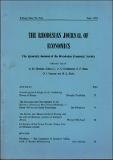| dc.contributor.author | Phimister, Ian R. | |
| dc.coverage.spatial | Southern Africa. | en |
| dc.coverage.spatial | Zimbabwe | en |
| dc.date.accessioned | 2015-12-15T12:32:19Z | |
| dc.date.available | 2015-12-15T12:32:19Z | |
| dc.date.issued | 1975-06 | |
| dc.identifier.citation | Phimister, I.R. (1975) The structure and development of the Southern Rhodesian base mineral industry: from 1907 to the Great Depression, The Rhodesian Journal of Economics, vol. 9, no.2, pp. 79-89. Harare: RES. | en |
| dc.identifier.uri | https://opendocs.ids.ac.uk/opendocs/handle/20.500.12413/7220 | |
| dc.description | A RJE article on the structure and development of the Southern Rhodesian Base Mineral Industry from 1907 to the mid 1930's. | en |
| dc.description.abstract | The British South Africa Company was originally lured in 1890 to what became Southern Rhodesia in anticipation of discovering extensive gold deposits, but over the next two decades evidence of the region’s diverse mineralisation accumulated. Prospectors soon found deposits of asbestos, chrome, mica, copper, sheelite, wolframite, tin and antimony, to list but a few. Of the many minerals discovered, only the first two named achieved significant and relatively consistent importance between 1907 and the Great Depression and consequently discussion will centre almost exclusively on them.' Mica is examined briefly as an example of the lesser minerals and the general problems of profitability and marketability which their extraction entailed.
Geology naturally imposed its own basic constraints on base mineral mining. Unlike the characteristic occurrence of gold in small, scattered deposits, chrome and asbestos deposits were often extensive but this was somewhat offset by the fact that ‘their grade is also frequently low and poses difficult problems in mining. Overall, base minerals shared with gold the unhappy distinction that compared
‘with similar deposits either in South Africa or other highly mineralized areas in the rest of the world, [their] mining in Southern _ Rhodesia is frequently associated with greater technical uncertainty, while the margin of profit is often small in relation to the risks involved.
But geological and kindred mining problems were never as pronounced for chrome and asbestos as they were for gold, especially as some of the major deposits lent themselves to open-cast working and the quality of certain asbestos grades was amongst the best in the world. | en |
| dc.language.iso | en | en |
| dc.publisher | Rhodesian Economic Society (RES), University of Rhodesia (now University of Zimbabwe). | en |
| dc.rights.uri | http://creativecommons.org/licenses/by-nc-nd/3.0/ | en |
| dc.subject | Industrial Development | en |
| dc.title | The structure and development of the Southern Rhodesian base mineral industry: from 1907 to the Great Depression | en |
| dc.title.alternative | The structure and development of the Southern Rhodesian base mineral industry | en |
| dc.type | Article | en |
| dc.rights.holder | University of Zimbabwe (UZ) (formerly University College of Rhodesia) | en |


